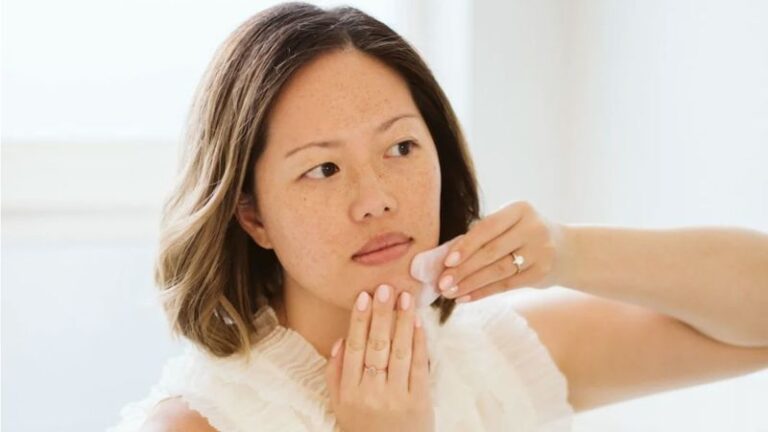
[ad_1]
Among all of the viral beauty hacks, gua sha is a legitimate practice with a centuries-old history. Not only does gua sha help lift and tone the face, it also aids in lymphatic drainage and reduces inflammation. Originating from Traditional Chinese Medicine (TCM), facial gua sha can be found all over TikTok and social media, thanks to its transformative abilities. Its virality has also led to the smooth stones used for gua sha becoming bona fide beauty tools, found on the shelves of Sephora and Ulta.
Here, we consult two Asian beauty brand founders and TCM experts about the traditions behind gua sha, its beauty benefits and how to incorporate it into your own skin care routine.
“Gua sha is a Traditional Chinese medical (TCM) practice that goes back centuries,” says Sandra Chiu, founder of Lanshin, licensed acupuncturist, herbalist and master of science in TCM. “The practice involves using a gua sha tool to stroke or ‘scrape’ tight, tense or pathological areas of the body to break down and remove blood stagnation in those areas. This in turn improves the circulation of blood, fluids and qi (energy). It was used to treat pain, and even illnesses as serious as cholera. Today, gua sha remains an important modality that TCM practitioners use to treat pain and boost immune function.”
“[It] is excellent for lymphatic drainage, addressing stagnant energy, promoting blood flow, soothing headaches, reducing inflammation, shortening acute illnesses like colds and flus and releasing tension from head to toe,” says Lin Chen, founder and CEO of Pink Moon.
There is a difference between medical gua sha and facial gua sha. According to Chiu, “Medical gua sha for treating pain, illness or internal disorder should only ever be done by a trained and licensed professional.” Facial gua sha, however, uses a “much slower speed and softer touch,” and is safe for people to practice at home.
While there have been studies to support the benefits of medical gua sha, there is still research to be done on facial gua sha. “There is a large body of modern research and evidence that shows anti-inflammatory and immune protective effects of [medical] gua sha treatment,” shares Chiu. “It has been shown to be effective in treatment of pain conditions as well as acute and chronic internal organ disorders, including liver inflammation in hepatitis.” For facial gua sha, the expert notes that there is a dearth of studies in the west; however, TCM universities in China have conducted studies “which demonstrate the efficacy of facial gua sha protocols in treating conditions like melasma and anti-aging concerns.”
Facial gua sha can help depuff and sculpt the face, increase circulation, release tension, ease headaches and even aid in alleviating blocked sinuses and congestion. Its most prominent beauty benefits have gone viral on TikTok, showing transformations where people’s faces appear more contoured and lifted.
Whether you’re using a gua sha tool to sculpt your face or you want to release tension, having the proper technique is important. Chen says the best way to learn is to get training from a licensed acupuncturist and TCM practitioner (“Look for an ‘L.Ac.’ behind their name, or a doctorate (Dr.) credential, which signals the acupuncturist has received a doctorate degree in Chinese medicine.”) or watch online tutorials by professionals. Lanshin has a number of helpful tutorials on its website and social media. TikTok can also be a great resource for how-to videos, with TCM experts like Dr. Laurel Liu and the founders of Yina, acupuncturist Angela Chau Gray and Dr. Ervina Wu, sharing their techniques.
Chen recommends doing five minutes of facial gua sha twice daily, or at least once a day, for the best results. Incorporating gua sha into your morning and/or evening skin care routines is an easy way to make it a consistent practice. According to Chen, doing facial gua sha in the morning can help with “reducing puffiness in the cheeks and under-eyes”, while gua sha at night “promotes relaxation and better sleep.”
When you’re ready to pick up your gua sha tool, here are some expert-approved guidelines for practicing gua sha.
- Start with a clean face. You can incorporate gua sha into your skin care routine by doing it right after you cleanse your face in the morning or evening.
- Prepare your skin. “Before doing gua sha, you want to make sure to prep your skin with something emollient like a face oil or a balm,” Chen says. Chiu agrees, saying that a face oil is optimal for providing “slipperiness.” You want your skin to be slick so the gua sha tool can glide easily without tugging.
- Keep the tool flat. Using the thin edge of the tool, as if perpendicular to the face, is a common mistake when doing gua sha. Instead, “Keep the stone as flat and close to the skin as possible, [at a] 15-degree angle so you don’t create unnecessary friction or tug your skin,” Chen says.
- Start on the neck. You can begin using the tool by gently scraping down each side of the neck. “On the neck you can use downward strokes and upward strokes,” Chiu advises. “However, you should do all the up strokes at once, and all the down strokes at once (don’t stroke up-down-up-down like you are painting a wall).”
- Use light pressure and go slowly. “Pressure varies depending on the area of the face or neck, but I recommend light to medium pressure, and always feather-light around the eyes,” says Chiu. “The face really responds to a ‘less is more’ approach.” You don’t want to rush through the routine either. Taking your time will yield better results and be less of a risk of bruising or pulling at the skin.
- Work outward. “On the face, the general rule is to stroke from the middle of your face outward and upward, using the flat body of your tool (not the thin edge of it),” shares Chiu.
- Don’t practice on acne. If you have an active breakout, Chen says you can skip the face and just do gua sha on the neck and chest. “This will help to increase circulation and decrease inflammation,” she says.
- A little redness is normal. Your skin may get a little pink or red during your gua sha routine, which indicates blood rushing to the surface of the skin. The small spots of red are the “petechiae” and represent a release of toxic energy.
When looking for a gua sha tool, the experts recommend choosing one that fits your face’s natural contours. The tool should be comfortable in your hand and against your face. They are often made out of natural stones like rose quartz and jade, which have natural cooling properties and are believed to hold spiritual and healing properties in TCM. When shopping for a gua sha tool made from these, it’s important to look for authentic natural stones — glass lookalikes are common — because they will last longer and are less likely to break. Shopping from an Asian-owned brand is another factor to consider, as gua sha is first and foremost a wellness practice rooted in TCM and supporting the community it comes from helps keep the traditions alive.
$60 at Yina

Created by TCM doctors, Yina’s gua sha tool is shaped and sized to be used on the face and body. It is made from Bian Shi stone, which contains more than 30 minerals that are believed to have healing benefits. According to the brand, “Mineralogy studies show that Bian stone creates far-infrared waves, ultrasound pulses and negative ions that help boost and regenerate healthy human cells and DNA.”
Note: The prices above reflect the retailers’ listed prices at the time of publication.
[ad_2]